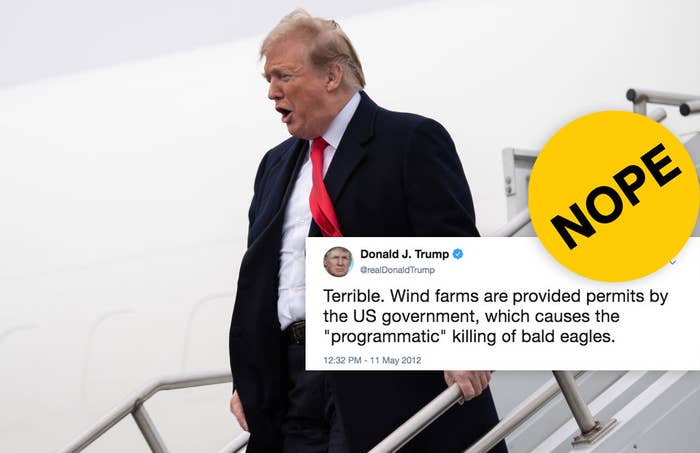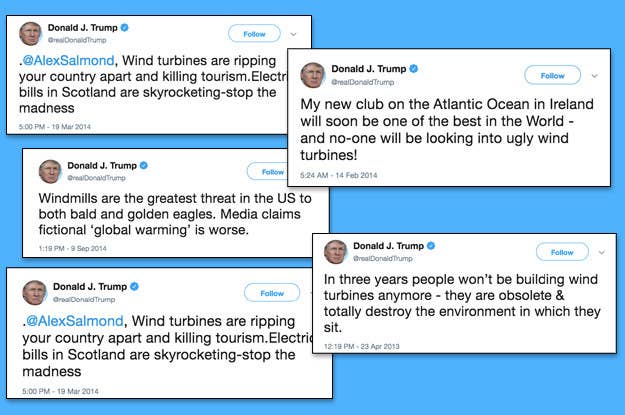
President Trump recycled a grab bag of debunked claims Tuesday about wind turbines killing birds, causing cancer, and knocking out your TV.
“The thing makes so much noise, and of course it’s like a graveyard for birds,” Trump said at a campaign fundraising dinner. “And they say the noise causes cancer. You tell me that one, okay?”
Trump had offered a different attack on wind power at a speech in Michigan last week, saying, “Windmills. Weeeee. And if it doesn’t blow, you can forget about television for that night.”
The president has criticized wind turbines — which he sometimes calls “windmills” — since 2012 on Twitter and during his rallies. He has primarily focused on turbine projects in Ireland and Scotland, where he would later open golf courses.
Between 2012 and 2014, Trump aggressively tweeted at the first prime minister of Scotland denouncing wind turbines and calling him “an embarrassment to Scotland.” In 2015, the British Supreme Court ruled that Trump could not stop an offshore wind farm near two of his Scotland golf courses, prompting a new series of attacks from the now-president.
His remarks Tuesday seem to have come out of nowhere. To support his debunked claims in the past, Trump has tweeted links to a handful of fringe websites. But searches of 4chan and the social media monitoring tool BuzzSumo show that there have been no recent claims online connecting wind farms and cancer. On 4chan, an anonymous forum that’s often the first to start and promote conspiracies, nobody’s mentioned wind farms and cancer for more than a year.
Trump’s statement on turbines and cancer parrots claims popularized years ago, known as the (debunked) wind turbine syndrome. It was pushed by online conspiracy theorists, who blamed wind turbines for all kinds of illnesses, from headaches to cancer. In at least one case, the spread of the myth was connected to an oil company in Australia. Multiple studies have since concluded there are no health risks to living around turbines.
Trump linked cancer to wind turbines in a 2012 tweet referencing wind power opponents, only his second tweet ever on the subject. A 2014 review in the journal PLOS One found “no conclusive evidence” of any health effects from wind turbines, aside from reports of people being woken up by turbines that average 35 decibels, just above a whisper in intensity.
More frequently, Trump has linked bird deaths to wind turbines, another popular narrative against the technology. “Terrible,” he tweeted in May 2012. “Wind farms are provided permits by the US government, which causes the ‘programmatic’ killing of bald eagles.”

There’s no support for the claim that turbines are systematically killing bald eagles or other birds. A 2014 study found that wind turbines aren’t even close to being the biggest bird killers; that honor belongs to cats, which kill more than 2 billion birds a year in the US and Canada, followed by cars and power lines, which together kill more than 600 million. Wind turbines kill about half a million birds every year, according to the study, less than 0.25% as many as cats do. Some wind turbines have also been redesigned to be shorter, keeping out of birds’ migration and feeding paths.
Several studies say that while wind turbines do affect the environment around them, those impacts can also be reduced. That’s another claim Trump has made in the past to argue against wind farms. One study of UK wind farms said that while the structures impact the habitats around them, picking good sites for wind farms and turning them into conservation areas could easily mitigate the negatives.
Trump also claimed that the arrival of a wind turbine in a given neighborhood would drop nearby home prices by 75%, an observation at odds with sales figures in wind power states. Similar studies in the UK and New Zealand have likewise found no effect of wind turbines on nearby home prices.
As for your TV suffering blackouts when the wind stops? That doesn’t happen because of the distributed nature of wind turbines feeding the power grid, which delivers electricity from multiple sources. A 2016 Institute of Electrical and Electronics Engineers analysis, for example, said it was “widely accepted across the power industry” that weather forecasts of wind strength actually made the power grid more reliable, not less.
Many of the attacks made by Trump regarding the unreliability or hidden costs of wind power originated with the UK’s nuclear power industry, which feared competition amid Europe’s move toward renewable energy a decade ago. Right-wing think tanks such as the Manhattan Institute, partly funded by the billionaire Koch brothers who own oil refineries, produced a spate of attacks calling wind turbines bird killers in 2012, complaints picked up by Fox News, a favorite source of Trump viewpoints.
Summing up Trump’s attacks, Brown University sociologist Robert Brulle, an expert on climate science denial rhetoric, said it “sounds like a garbled version of the ‘unreliability and intermittent nature of wind power’ talking points,” taken from fossil fuel industries and other economic opponents of renewable energy.
For Trump, beating up on wind power is just political shorthand for punching hippies, suggested some experts. That’s why the truth or falsehood of his “simplistic and outdated” attacks on wind power don’t matter to his supporters, political communications scholar Jen Schneider of Boise State University told BuzzFeed News by email.
In his remarks, the president is telling his supporters a comforting political story, she said: “the sense that environmentalists are elitists who care more about the environment than about you.”
“He’s tapping into common stories we tell about the left’s hypocrisy and the right’s realism. These stories still have a lot of sway.”

